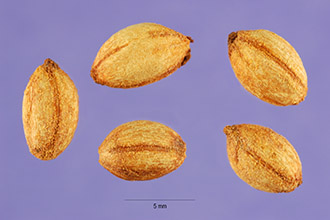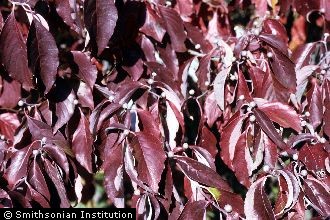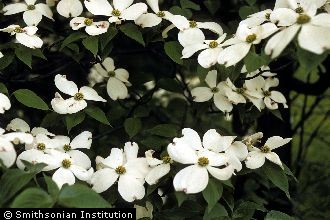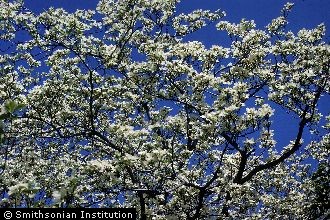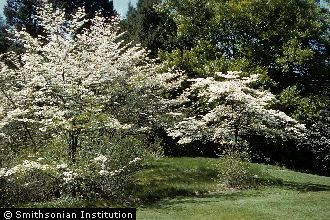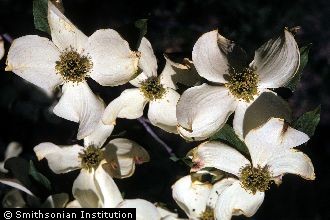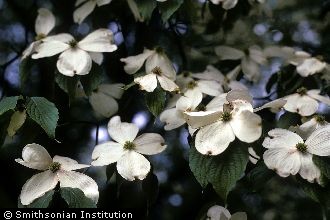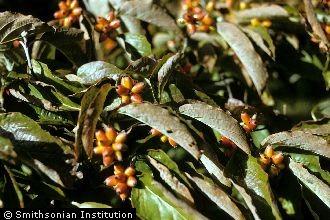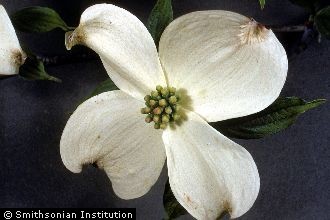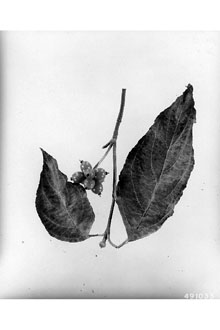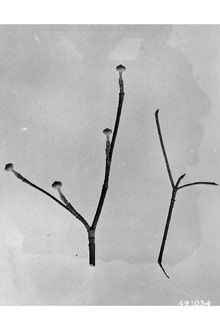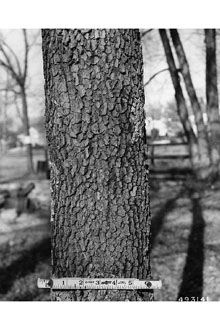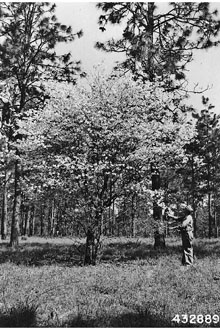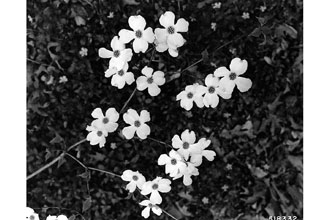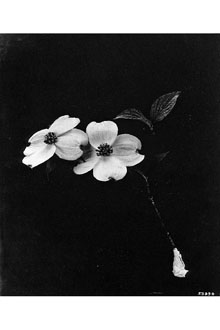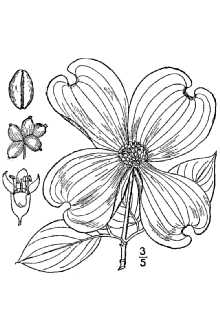Benthamidia florida (L.) Spach
Scientific Name: Benthamidia florida (L.) Spach
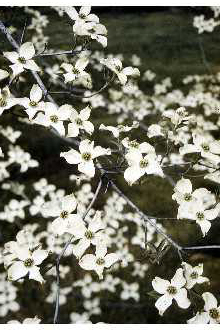
| General Information | |
|---|---|
| Usda Symbol | BEFL |
| Group | Dicot |
| Life Cycle | Perennial |
| Growth Habits | ShrubTree, |
| Native Locations | BEFL |
Plant Guide
Alternate Names
American boxwood, arrowwood, Benthamia florida, boxwood, cornel, cornelian tree, Cornus candidissima, Cornus florida forma pendula, Cornus florida forma pluribracteata, Cornus florida forma xanthocarpa, Cornus florida var. pendula, Cornus florida var. rosea, Cornus florida var. rubra, Cynoxylon floridum, dogwood, eastern flowering dogwood, white cornel, white dogwood. WARNING: The fruit of flowering dogwood is poisonous to humans.
Uses
Ethnobotanic: Flowering dogwood root bark was used by Native Americans as a fever reducer, skin astringent, an antidiarrheal agent, and as a pain reliever for headaches, sores, and muscle inflammations. It was also used to counteract the effects of many poisons and as a general tonic for unspecified ailments. The bark was used for headache and backache relief, as a throat aid for hoarseness, and as an infusion for childhood diseases like worms and measles. Flowers were infused to reduce fever and relieve colic pains. Compound infusions of several plant parts were used as blood purifiers and as medicine for blood diseases like malaria. Ornamental: The showy blossoms and attractive fall foliage make flowering dogwood a valuable ornamental species. It is commonly used in landscape and street plantings. As a garden tree, it is used for shade around patios, as a shrub border or backdrop species, or as single specimens in the lawn. It is best suited for plantings receiving less than full-day sun. C.W. Cook. 2003. Restoration: Flowering dogwood is a soil improver because its leaf litter decomposes more rapidly than most other species. For this reason flowering dogwood has been planted on abandoned strip mines and used for urban forestry projects. Wildlife: Flowering dogwood is a valuable food plant for wildlife because high calcium and fat contents make it palatable. Many bird types including songbirds, forest edge species, and upland game birds (e.g. wild turkey) consume the seeds. The eastern chipmunk, white-footed mouse, gray fox, gray squirrel, black bear, beaver, white-tailed deer, and skunk readily consume flowering dogwood seeds as well. Beaver, rabbits, and deer browse the leaves and sprouts of the plant. Flowering dogwood also provides shelter and habitat for many wildlife species. Wood production: The wood of flowering dogwood has been harvested for the manufacture of tool handles, charcoal, wheel cogs, hayforks, and pulleys. It is occasionally used to make specialty items like golf club heads, roller skate wheels, knitting needles, and spools. The wood is hard, strong, and shock resistant, making it suitable for wood products that need to withstand rough use.
Legal Status
Status
Status
Flowering dogwood is endangered in Maine, exploitably vulnerable in New York, and threatened in Vermont. Please consult the PLANTS Web site (http://plants.usda.gov) and your State Department of Natural Resources for this plant’s current status (e.g. threatened or endangered species, state noxious status, and wetland indicator values).
Description
General: Dogwood Family (Cornaceae). Flowering dogwood is a deciduous multi-branched shrub or small tree, characterized by a rounded crown and horizontal branches that spread wider than its height. Flowering dogwood is typically 5 to 15 m tall. The bark on mature trees is broken into small square blocks that give the stem an “alligator” appearance. Leaves are opposite, simple, medium-green in color, 7.6 to 15 cm long, and less than 7 cm wide. The veins follow the elliptic curve of the leaf (arcuate). Autumn foliage turns red or purple. The flowers are yellow, very small, and clustered into inflorescences that are surrounded by 4 large white (pink) bracts. Each bract has a rounded notch on the outer edge. The fruit are yellow to red berrylike drupes that contain one to two cream-colored, ellipsoid seeds. Flowers appear between March and June, with or before the leaves, and persist for 2 to 4 weeks. Fruits ripen in September and October. Key characteristics of flowering dogwood are its opposite leaves with arcuate venation, large showy flowers (bracts), onion-shaped terminal flower buds, and alligator bark on mature trees. Distribution: Flowering dogwood is native to the northeastern and southeastern United States. It occurs from Maine, south to Florida and west to eastern Texas, Missouri, Illinois, and southern Michigan. For current distribution, please consult the Plant Profile page for this species on the PLANTS Web site (http://plants.usda.gov). Habitat: Flowering dogwood is an important understory species in the eastern deciduous and southern coniferous forests. It is also found on floodplains, slopes, bluffs, ravines, gum swamps, along fencerows, and in old-field communities. It is mentioned in 22 of the 90 Society of American Foresters forest cover types including jack pine, beech-sugar maple, eastern hemlock, oak-hickory, and prairie.
Adaptation
The USDA hardiness zones for flowering dogwood is 5 to 9. Flowering dogwood trees grow best in course to medium textured, well-drained soils with a pH range of 6 to 7. They are sensitive to rapidly changing soil temperature and are most abundant in temperature-consistent woodland soils. Although they are tolerant of seasonal dry periods, they are not tolerant of severe drought or heavy, saturated soils. The inability to grow on extremely dry sites is attributed to their shallow root system. Flowering dogwood is an indicator of rich soil (mesic sites), but smaller trees will occur on more xeric sites. Trees growing in the mesic sites are more susceptible to dogwood anthracnose (see Pests and Potential Problems). In the future, flowering dogwood may only be found on poor, dry sites. Partial or broken shade is best, but flowering dogwood can tolerate full sun. It does best with some shade in the south and full sun in the north. Shaded trees are less dense, grow more quickly and taller, and have poor flowering and fall color. Trees exposed to more sun are stouter, bushier, and produce more flowers. Flowering dogwood is not tolerant of stresses such as heat, drought, pollution, or salt. These stresses make flowering dogwood more susceptible to disease, pests, and other problems.
Establishment
Flowering dogwood is intolerant of extended drought periods, especially during the first year after planting. Daily watering is necessary for the first few weeks following planting. After one month, watering should be reduced to two times per week and continue for one year. Establishment takes 6 to 12 months for each inch of trunk diameter. Larger trees benefit from irrigation during the second year.
Management
Flowering dogwood is moderately resistant to herbicides although direct application of Garlon has killed the plant. Mechanically cutting stems results in smaller resprouts. Midsummer-cut regeneration is typically smaller and shorter than regeneration from winter-cut. Plants commonly resprout from the root crown after aboveground vegetation is damaged or destroyed by fire. The aboveground portions of flowering dogwood are readily damaged by fire because the thin bark allows fatal levels of heat to reach the cambium very quickly. Post-fire recovery is generally more rapid after surface fires than after crown fires. Extreme soil moisture and flooding is detrimental to the survival of flowering dogwood. The tree can be uprooted in saturated soil. Excess water also leaves this plant susceptible to pests and diseases. Established trees in partial or deep shade need irrigation only in times of drought. Those in full sun will need regular irrigation throughout their lives.
Pests and Potential Problems
Dogwood borer larvae move through openings in the bark and feed on the trunks of flowering dogwood. If the cambium is destroyed, branches or the entire tree will die. Leaves will turn red and drop early, and bark will slough off around holes on the trunk or branches. An advantageous point of entry for larvae is through wounds. For this reason, avoid hitting the trunk with lawn mowers or string trimmers to prevent infestation. Insecticides are preventative, but will not control an existing infestation. Twig borers will kill the tips of young twigs, but rarely kill an entire tree because they are usually present in small numbers. Twig borers tunnel through the pith and deposit ambrosia fungi as a food source for larvae. This infestation causes wilted leaves at the end of branches, and can be controlled by pruning infected twigs below the discolored pith area. Larvae of the dogwood club-gall midge cause twigs to swell at the base of flowering dogwood leaves. An early symptom of club gall is a wilted, deformed leaf. The twig beyond the gall may die, but galls can be pruned and destroyed. In early fall, larvae drop from the gall to over winter on the ground. A light infestation is not harmful, but a heavy infestation will stunt the growth of the tree. Flowering dogwood is threatened by dogwood blight caused by the dogwood anthracnose fungus. Tan and purple colored leaf spots develop in the lower canopy and progress up the tree. Infection spreads into the shoots, main branches, and trunk causing cankers to form. Multiple cankers can girdle the trunk and kill the tree. Diseased trees produce shoots that also become infected on the lower trunk and leaves. Stressful environmental conditions like drought or acid rain may weaken trees, predisposing them to dogwood blight. Dogwood blight can be controlled if the disease is detected before branch dieback begins. Prune and remove all dead twigs, dead limbs, and new shoots, and rake and remove fallen leaves. Remove crowding vegetation and thin the canopy to promote air circulation. Avoid nitrogen fertilizer. Fungicides can prevent infestations of new leaves and flowers. Spot anthracnose attacks flowering dogwood leaves, stems, flowers, and buds. Spots are usually very small with reddish or purplish borders. Severe infestations can prevent flower buds from opening, distort leaves, and weaken trees. Fungicides containing bordeaux 4-4-100, chlorothalonil, or mancozeb can control spot anthracnose on new plant tissue. Clean up and dispose of infected leaves on the ground near the tree since this is where the fungi survive the winter. Cankers form at wound sites and allow entrance to harmful insects and fungi. Initial symptoms of cankers are blackened or water soaked areas on the bark. This area will grow and will ooze a black liquid. Leaves will appear smaller and paler. Cankers cannot be controlled. Prevent formation by avoiding trunk wounds. Root injury, over-fertilization, or lack of soil drainage can lead to root rot. Powdery mildew forms on new growth causing reddish discoloration, premature defoliation, and dead patches. Leaf scorch symptoms are browning and drying leaf margins. These symptoms can be caused by a lack of available soil moisture, transplanting shock, fertilizer or salt injury to roots or root rot diseases. Raking up fallen leaves and improving air circulation through the canopy can control and prevent powdery mildew and leaf scorch.
Seeds and Plant Production
Plant Production
Plant Production
Flowering dogwood seeds can be hand-sown into outdoor beds soon after collection (September to October). This allows for the seeds to undergo natural warm stratification prior to exposure to cooler winter temperatures. Imbibe seeds overnight, dust with fungicide, and hand-sow 5 to 6 inches apart in rows. Sprinkle endomycorrhizae over the seed before covering with soil. Mulch the bed with sawdust. Seeds can be artificially cold stratified for 100 to 130 days and germinated at 15 to 27oC. Prior to spring emergence (March to April), remove mulch. Place shade cloth above newly emerged seedlings and keep it in place until August. Flowering dogwood can also be propagated by cutting, grafting, layering, and root division. It roots easily from cuttings taken in June or immediately after the plants bloom. Cut 8 cm of the terminal shoot tip, keeping 2 to 4 leaves, and dip into a one part indole-butyric acid (IBA) to 250 part talc (by weight) mixture. Set cuttings approximately 3 cm deep in rooting medium and grow under a misting system with a photoperiod of at least 18 hours. Plants are best suited for transplanting at the beginning of the third year. Seedling survival is generally best on moist, rich, well-drained soils. Flowering dogwood may be difficult to transplant, but seedlings with a root ball are more successful than bare root transplants. Cultivars, Improved, and Selected Materials (and area of origin) Several cultivars of flowering dogwood are readily available from commercial sources. These cultivars have been developed for leaf color and variegation, flower color, fruit color, plant height, growth rate, and disease resistance. Some examples of flowering dogwood cultivars include ‘Apple Blossom,’ ‘Bay Beauty,’ ‘Cherokee Brave,’ ‘Cherokee Chief,’ ‘Cloud 9,’ ‘First Lady,’ ‘Mystery,’ ‘Purple Glory,’ ‘Sweetwater Red,’ and ‘Welchii.’
References
Agricultural Research Center, 2004, GRIN taxonomy (http://www, Use soil moisture sensors to measure the soil moisture of Benthamidia florida (L.) Spach.,ars-grin,gov/cgi-bin/npgs/html/index, 19 May 2004), USDA, Beltsville, Athenic Systems, 2004, North American Trees (http://www,treeguide,com/namerican_tree,asp, 19 May 2004), Nature Hills Nursery, Omaha, Baskin, C,C, and J,M, Baskin, 2001,
Fact Sheet
Uses
Wildlife: The fruit is choice fall and winter food of the gray squirrel and fox squirrel, bobwhite, cedar waxwing, cardinal, flicker, mockingbird, robin, wild turkey, and woodpecker. The leaves and twigs are choice food for the white-tailed deer. It is not an important nesting plant. Ornamental: It is an important ornamental tree used around homes and office buildings because of its striking display when it is in full bloom.
Status
Please consult the PLANTS Web site and your State Department of Natural Resources for this plant’s current status (e.g. threatened or endangered species, state noxious status, and wetland indicator values).
Description
Cornus florida L., flowering dogwood, is a small, bushy tree which rarely attains a height of more than 40 feet or a diameter of 12 to 18 inches. The leaves are opposite one another and from 3 to 6 inches long. The deeply ridged and broken bark resembles alligator hide. Flowering dogwood has large, showy, deeply notched bracts, 4 of which surround each cluster of inconspicuous perfect flowers, in bloom from May to June. The fruit clusters on this shrub-like tree are scarlet red.
Adaptation and Distribution
Distribution
Distribution
Flowering dogwood is adapted to most upland sites but grows best on rich, well-drained soils on middle and lower slopes. It develops best as an understory species in association with other hardwoods. Flowering dogwood is distributed throughout the eastern United States. For a current distribution map, please consult the Plant Profile page for this species on the PLANTS Website.
Establishment
Plants can be grown from seed planted 1/2 inch deep in late winter.
Management
In tree harvest or timber stand improvement operations, specify that 5 or 6 dogwoods per acre be left in the forest for aesthetic purposes and as a food source for squirrels, turkeys, deer, and non-game birds, Leave all dogwoods along highways and roads, Use soil moisture sensors to measure the soil moisture of Benthamidia florida (L.) Spach., Robert H, Mohlenbrock USDA NRCS 1995 Northeast Wetland Flora @USDA NRCS PLANTS
Plant Traits
Growth Requirements
| Temperature, Minimum (°F) | -28 |
|---|---|
| Adapted to Coarse Textured Soils | Yes |
| Adapted to Fine Textured Soils | No |
| Adapted to Medium Textured Soils | Yes |
| Anaerobic Tolerance | None |
| CaCO3 Tolerance | Low |
| Cold Stratification Required | Yes |
| Drought Tolerance | Low |
| Fertility Requirement | Medium |
| Fire Tolerance | Medium |
| Frost Free Days, Minimum | 160 |
| Hedge Tolerance | Low |
| Moisture Use | Low |
| pH, Maximum | 7.7 |
| pH, Minimum | 4.8 |
| Planting Density per Acre, Maxim | 2700 |
| Planting Density per Acre, Minim | 1200 |
| Precipitation, Maximum | 80 |
| Precipitation, Minimum | 28 |
| Root Depth, Minimum (inches) | 18 |
| Salinity Tolerance | None |
| Shade Tolerance | Tolerant |
Morphology/Physiology
| Bloat | None |
|---|---|
| Shape and Orientation | Erect |
| Nitrogen Fixation | None |
| Resprout Ability | Yes |
| Active Growth Period | Spring and Summer |
| C:N Ratio | High |
| Coppice Potential | No |
| Fall Conspicuous | Yes |
| Fire Resistant | No |
| Flower Color | White |
| Flower Conspicuous | Yes |
| Foliage Color | Green |
| Foliage Porosity Summer | Porous |
| Foliage Porosity Winter | Porous |
| Fruit/Seed Color | Red |
| Low Growing Grass | No |
| Lifespan | Short |
| Leaf Retention | No |
| Known Allelopath | No |
| Height, Mature (feet) | 30.0 |
| Height at 20 Years, Maximum (fee | 20 |
| Growth Rate | Moderate |
| Growth Form | Multiple Stem |
| Fruit/Seed Conspicuous | Yes |
| Foliage Texture | Medium |
Reproduction
| Vegetative Spread Rate | None |
|---|---|
| Small Grain | No |
| Seedling Vigor | Medium |
| Seed Spread Rate | Slow |
| Seed per Pound | 4480 |
| Fruit/Seed Persistence | Yes |
| Propagated by Tubers | No |
| Propagated by Sprigs | No |
| Propagated by Sod | No |
| Propagated by Seed | Yes |
| Propagated by Corm | No |
| Propagated by Cuttings | Yes |
| Bloom Period | Early Spring |
| Commercial Availability | Routinely Available |
| Fruit/Seed Abundance | Medium |
| Fruit/Seed Period Begin | Spring |
| Fruit/Seed Period End | Fall |
| Propagated by Bare Root | Yes |
| Propagated by Bulb | No |
| Propagated by Container | Yes |
Suitability/Use
| Veneer Product | No |
|---|---|
| Pulpwood Product | No |
| Protein Potential | Low |
| Post Product | No |
| Palatable Human | No |
| Palatable Graze Animal | Low |
| Palatable Browse Animal | Medium |
| Nursery Stock Product | Yes |
| Naval Store Product | No |
| Lumber Product | No |
| Fuelwood Product | Low |
| Fodder Product | No |
| Christmas Tree Product | No |
| Berry/Nut/Seed Product | No |

